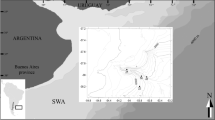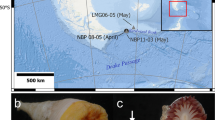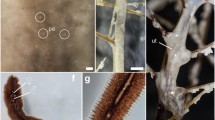Abstract
The gametes of many groups of anthozoans contain a funnel-shaped cluster of specialized cells that facilitate the transport of nutritive substances, known as the trophonema. This structure has been found within all orders of anthozoans, with the exception of pennatulaceans, scleractinians, and antipatharians, the latter of which are commonly known as black corals. Based on the histological study of eight specimens of the black coral Dendrobathypathes grandis Opresko (Zool Med Leiden 76(22):411–442, 2002) from the southwestern Atlantic, we report for the first time the presence of a trophonema within the order Antipatharia. A trophonema was found only in oocytes from one of the seven female specimens studied. Since D. grandis contains the largest oocytes among antipatharians that have been studied to date, it remains unknown whether the presence of a trophonema is an exceptional case, or whether these structures have simply been overlooked in other black corals.

Similar content being viewed by others
References
Cairns SD (2007) Deep-water corals: an overview with special reference to diversity and distribution of deep-water scleractinian corals. Bull Mar Sci 81:311–322
Couch R (1842) An essay on the zoophytes of Cornwall. Annu Rep R Cornwall Polytech Soc 9:27–91
Dunn DF (1975) Reproduction of the externally brooding sea anemone Epiactis prolifera Verrill, 1869. Biol Bull 148:199–218
Eckelbarger KJ, Tyler PA, Langton RW (1998) Gonadal morphology and gametogenesis in the sea pen Pennatula aculeata (Anthozoa: Pennatulacea) from the Gulf of Maine. Mar Biol 132:677–690
Eckelbarger KJ, Hand C, Uhlinger KR (2008) Ultrastructural features of the trophonema and oogenesis in the starlet sea anemone, Nematostella vectensis (Edwardsiidae). Invert Biol 127(4):381–395
Fautin DG, Mariscal RN (1991) Cnidaria: Anthozoa. In: Harrison FW, Westfall JA (eds) Microscopic anatomy of invertebrates. Vol. 2: Placozoa, Porifera, Cnidaria, and Ctenophora. Wiley–Liss, New York. pp. 267–358
Hertwig R (1882) Die Actinien der Challenger expedition. Gustav Fischer, Jena
Hertwig O, Hertwig R (1879) Die Actinien: Anatomisch und Histologisch, mit besonderer Berucksichtigung des Nervermuskelsystems Untersucht. Gustav Fischer, Jena
Humason G (1967) Animal tissue techniques. Freeman and Company, San Francisco
Larkman AU, Carter MA (1982) Preliminary ultrastructural and autoradiographic evidence that the trophonema of the sea anemone Actinia fragacea has a nutritive function. Intl J Invert Reprod 4:375–379
Lauretta D, Penchaszadeh PE (2017) Gigantic oocytes in the deep sea black coral Dendrobathypathes grandis (Antipatharia) from the Mar del Plata submarine canyon area (southwestern Atlantic). Deep Sea Res Part I 128:109–114
Moseley H (1877) On new forms of Actiniaria dredged in the deep sea; with a description of certain pelagic surface-swimming species. Trans Linn Soc Lond Series 2(1):295–305
Nyholm KG (1943) Zur Entwicklung und Entwicklungsbiologie der Ceriantharie und Aktinien. Zool Bidr Uppsala 22:87–248
Opresko DM (2002) Revision of the Antipatharia (Cnidaria: Anthozoa). Part II. Schizopathidae. Zool Med Leiden 76(22):411–442
Schmidt H, Schaefer WG (1980) The anthozoan egg: trophic mechanisms and oocyte surface. In: Tardent P, Tardent R (eds) Development and Cellular Biology of Coelenterates. Elsevier, Amsterdam, pp 41–46
Schmidt H, Zissler D (1979) Die Spermien der Anthozoen und ihre phylogenetische Bedeutung. Zoologica 129:1–98
Shikina S, Chang C-F (2016) Sexual reproduction in stony corals and insight into the evolution of oogenesis in Cnidaria. In: Goffred S, Dubinsky Z (eds) The Cnidaria, Past, Present and Future. Springer, Berlin, pp 249–269
Suvarna SK, Layton C, Bancroft JD (2013) Bancroft’s theory and practice of histological techniques. Churchill Livingstore, Elsevier, London
Wagner D, Waller RG, Toonen RJ (2011) Sexual reproduction of Hawaiian black corals, with a review of the reproduction of antipatharians (Cnidaria: Anthozoa: Hexacorallia). Invert Biol 130(3):211–255
Wagner D, Luck DG, Toonen RJ (2012) The biology and ecology of black corals (Cnidaria: Anthozoa: Hexacorallia: Antipatharia). Adv Mar Biol 63:67–132
Acknowledgements
Many thanks to the captain and crew of the O/V Puerto Deseado for their assistance and to the anonymous rewires for their valuable comments. This work was supported by a PICT 2013-2504 Grant to PP and a PADI foundation Grant to DL. Many thanks to Cristina Damborenea and Florencia Arrighetti for comments on the histology interpretation.
Author information
Authors and Affiliations
Corresponding author
Ethics declarations
Conflict of interest
On behalf of all authors, the corresponding author states that there is no conflict of interest.
Additional information
Topic Editor Dr. Anastazia Banaszak
Rights and permissions
About this article
Cite this article
Lauretta, D., Wagner, D. & Penchaszadeh, P.E. First record of a trophonema in black corals (Cnidaria: Antipatharia). Coral Reefs 37, 581–584 (2018). https://doi.org/10.1007/s00338-018-1682-1
Received:
Accepted:
Published:
Issue Date:
DOI: https://doi.org/10.1007/s00338-018-1682-1




